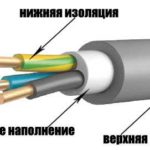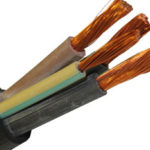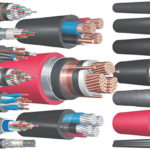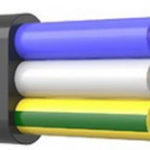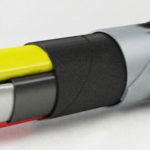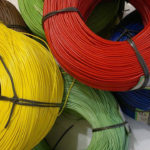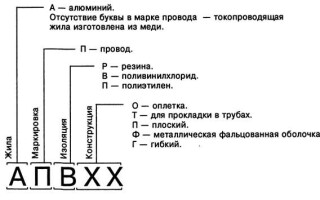The marking of cables, cords and other products intended for electrical wiring is a detail that is extremely important. This term should be understood as a cipher from a set of letters and numbers applied to the insulation of cable products - decoding examples and a table will help even a beginner to understand this issue.
Content
What is labeling for?
There are dozens of types of electrical wires and various cables on the goods market, the technical indicators of which vary. At the same time, it is impossible to select the desired products in appearance, since visually many wires are identical. Labeling can help.
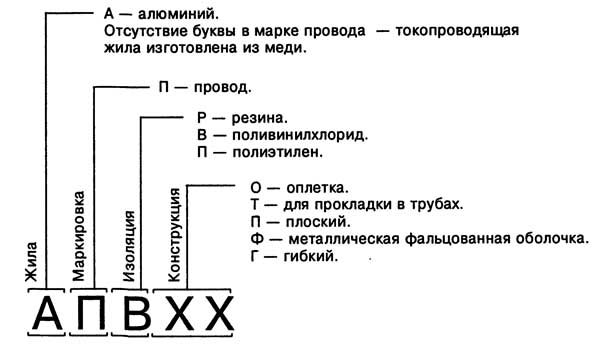
Classification of cables occurs according to the generally accepted system. At the same time, an alphabetic or numerical designation is adopted for the most important features of the product. Thus, marking makes it easier to decipher the brand of the cable.
General principles for marking cable products
The basic standards and principles for marking wires and cables are similar. At the same time, there is no great difficulty in deciphering. The main thing is to remember a few rules.
To identify cable products, a marking is used, consisting of 7 groups, including letters and numbers. The code has the following form: X XXX XXX XXX XXX XXX XXX.
Each numeric and alphabetic value is written in a strictly designated order. Stands out:
- 1 group. It testifies to the material lived.
- 2 group. Here the material is indicated, and which the armor, protection, insulation of cores or shells is made of. The marking of the armored cable is also indicated here.
- 3rd group. Design features are indicated (these include the possibility of using the product for laying in the ground, pipes).
- 4 group. It has a numerical indicator, which means the number of cores in the cable. The absence of a figure shows that she lived here alone.
- 5 group. Means the cross-sectional area, which is expressed in mm².
- 6 group. From this characteristic, you can find out the rated voltage of the network.
- 7 group. At the end of the marking indicate the standard according to GOST or TU.
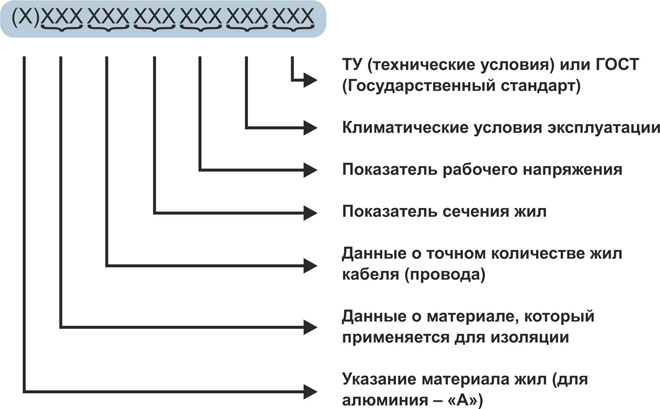
Using such a scheme, you can get comprehensive information on decoding the marking of cables and wires.
Type of insulation, armor and protection
The interpretation of the cable abbreviation should be carried out taking into account generally accepted standards.
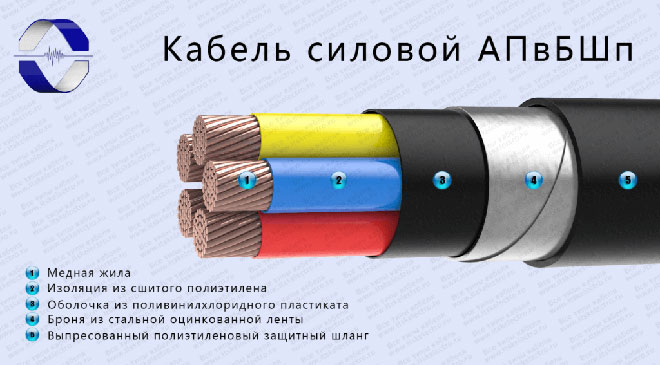
Core material
There are only 2 options here:
- the absence of a letter - copper (copper wire does not need any designation);
- “A” is the letter designating conductors made of aluminum.
In deciphering abbreviations, abbreviations, the data from this table will help.
| Letter designation of insulation material (2nd position) | |
|---|---|
| AT | This type of insulation is made of polyvinyl chloride (in other words, PVC). |
| P | In the manufacture of insulation, polyethylene was used. |
| R | Rubber is used for insulation. |
| HP | Nairite (made of non-combustible rubber) |
| C | Film insulation (used in the manufacture of mounting wires) |
| G | The protective layer is completely absent (naked). |
| F | Fluoroplastic |
| To | This letter indicates the control cable (its purpose). |
| KG | Flexible cable |
Letter designation of the containment, if any (3rd position) | |
| BUT | Made from aluminium. |
| P | Protective sheath - polyethylene hose |
| Pu | Reinforced polyethylene hose |
| FROM | lead sheath |
| R | Made from rubber |
| AT | PVC (polyvinyl chloride) sheath |
Letter designations of the material for the manufacture of the type of armor, if any (4th position) | |
| BBG | The armor consists of a profiled tape made of steel. |
| bn | The armor consists of steel strips provided with a protective cover, the material does not support combustion. |
| AT | Polyvinyl chloride used |
| Bl | Armor from steel tapes, Bl |
| D | The braid is made from double wire. |
| To | Round steel wires are used as armor, which are enclosed in a steel cover. |
| P | Flat steel wire armor |
| D | A braid consisting of two wires is used. |
Variety of used cable outer cover (5th position) | |
| E | Shielded cover (often this type is represented by aluminum foil) |
| G | There is waterproofing (protects against corrosion) |
| AT | This letter designation can have 2 decodings. If it is in the middle, the protective sheath is PVC, the second variety is the location of the "B" at the end. This means that the cover is made of paper. |
| O | Wires covered with insulation and connected with a winding |
| H | Cover made of non-combustible material |
| Shp | Protection is represented by a polyethylene hose. |
| Shv | Hose made of vinyl |
| shps | Polyethylene, self-extinguishing |
Communication cables are marked with the following abbreviations. The abbreviation can contain the following values:
- MK - means the main cable;
- Ш - mine;
- MK - these letters are applied to the main cables;
- RK - the abbreviation indicates a radio frequency cable;
- T - designed for telephone communications;
- O - optical type;
- KS - cable products for communication;
- KM - characterizes the combined main view;
- VK - these letters characterize intrazonal communication cables;
- PPP - insulation is presented in the form of a three-layer film (film-pore-film).
- Z - in this type of cable, the cores are twisted into a “star” four.
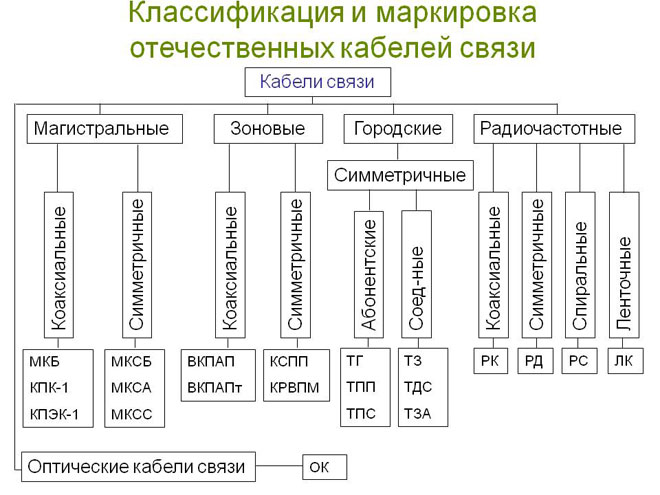
Deciphering digital values
After the letter designations in the marking of power cables, several numbers are indicated. It takes a little effort to decrypt:
- 1 position. This indicates the operating voltage for which this type is designed. In the absence of such a figure, the cable is used for a voltage of 220 V.
- 2 position. This indicator means how many conductors are present in the cable product.
- 3 position. Here indicate the cross section of the working core. The second and third positions are indicated through the "x" sign. For example, 3 x 16 (where 3 is the number of cores, and 16 is their cross section).
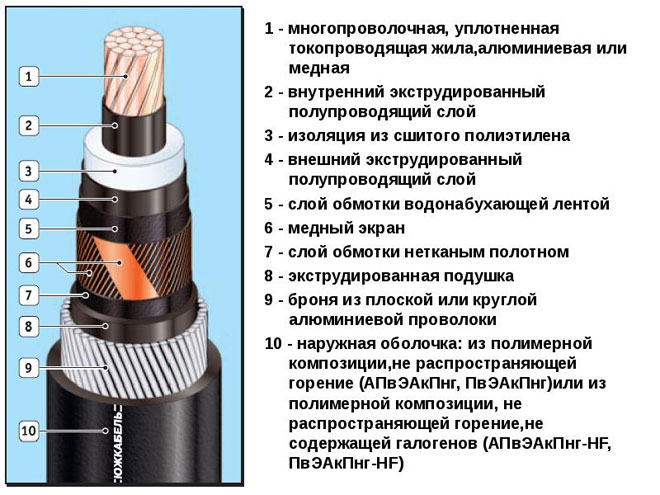
If there are cores of the same cross section, then the digital marking ends. When a “zero” core is present, it has a smaller cross section. In this case, the “+” sign is used and the number and cross section of the “zero” core are indicated.For example, 3 x 16 + 1 x 10.
Decryption examples
If the principle of reading abbreviations is clear, then there should be no problem finding the right product. For an example of decryption, you should pay attention to common combinations:
- APvPu2g. This marking indicates the presence of aluminum wires (A). Cross-linked polyethylene (PV) was used to insulate the wires. The cable sheath was made of reinforced polyethylene (Pu). In addition, there is double waterproofing - this can be understood by the expression "2g".
- APvPu. In this variant, there are conductors made of aluminum (A), wire insulation made of cross-linked polyethylene (PV) and a sheath with reinforcement made of polyethylene were used.
- KSSh 50x2x0.64. This marking of communication cables is common. It shows: this is a communication cable (CS), refers to mine (SH). The number of pairs reaches 50, 2 cores are twisted into pairs. The conductor diameter is 0.64 mm2.
- VVGng-frls. Against the background of the rest, the frls cable is different. The abbreviation indicates the following. The conductors are made of copper (the absence of the letter A). The core insulation is made of PVC. The outer shell is represented by polyvinyl chloride. The cable has no additional armor (i.e. naked) and does not burn (the letters “ng” testify to this). FR - Fire Resistance, the presence of the LS index characterizes a small amount of smoke during smoldering.
Wire marking
For wires and cable products, some features differ, the difference lies in the greater flexibility of the wires and their smaller cross section. In addition, the wires are divided into stranded and single-core. You can distinguish the wire by the letters “P” in the marking. She is listed in 2nd place.
Another feature is the indication of design characteristics:
- G - the wire is flexible;
- C - used for connections;
- T - suitable for pipe laying.
Otherwise, the principle of designating cables and wires is similar.

